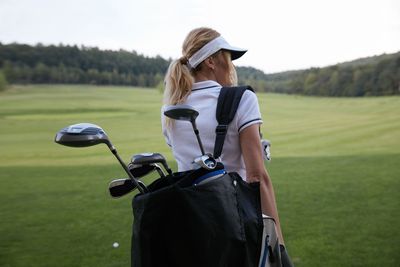by Jacqueline Birdsall, DPT, TPI and Chelsea Ortega, DPT, SCS, CSCS
Kinematic Sequence
The proper kinematic sequence at the start of the downswing is crucial to produce an effortless but powerful swing: lower body, trunk/torso, arms, and lastly, the club transferring energy into the ball at contact. The overall swing is a transfer of energy from one segment to the next. If one of the links is not working properly, it affects the following segment causing the swing to be less efficient and can ultimately cause decreased swing speed or swing faults, such as coming over the top or casting.
Each segment starts to decelerate once the next segment starts to accelerate. The hips are the first to decelerate which causes the trunk to accelerate. When the trunk decelerates, the shoulders accelerate and when the shoulders decelerate, the club accelerates into contact.

All impressive ball strikers follow this segment to make the most efficient swing. There are many golfers on tour who have very different styles from each other, but all share a similar kinematic sequence at the core. Body type and physical limitations play a role in creating each person’s unique swing. TPI has found 3 factors that can cause a breakdown in the kinematic sequence: improper swing mechanics, physical limitations, and improperly fit equipment.
Improving the kinematic sequence will not only make your swing more efficient, but will also significantly reduce stress on the body. How many times have you played a round of golf and found yourself running out of gas and your swing breaking down by the 12th, 13th or maybe even the 9th hole? It can be exhausting relying on the upper body to produce power and can ultimately lead to injury. There can also be many other factors contributing to fatigue on the course, but improving kinematic sequence can only help.
Newton’s third law states that for every action/force, there is an equal and opposite reaction. The more force we put into the ground through our lower extremities, the greater the reaction force producing more speed and power to the swing. That being said, strengthening is vital.
The proper kinematic sequence is key to an efficient swing, but that’s only part of the equation. In order to effectively produce that efficient swing, you must include a holistic approach that includes overall mobility, strength and power to support the swing. The following exercises address this approach.
Single Leg Stork Turns (2 sets x 25”)
Begin standing while holding on to a pole or golf club for support. Hook one leg around the back of the knee of the down leg for support. Try to rotate the pelvis and hips back and forth for 25 seconds without moving the upper body. Repeat on the other side.
Supported Pelvic Rotation (2 sets x 30”)
Stand holding onto pole or use a golf club. Keeping your shoulders facing forward, try to rotate the hips right and left without moving the upper body. Reach maximum rotation but don’t force a stretch.
½ Kneel Lift (2 sets x 10 reps)
Start by kneeling with the knee closest to anchor down and other bent to 90 degrees. With resistance coming from the ground level, grab the band with both hands and pull as you rotate from down to up over opposite shoulder. Lead with belly button and keep hips and pelvis still.
Side Step Up Hip Twister (2 sets x 8-10 reps)
Grab a medicine ball in both hands and place the left foot on a 6-inch to 12-inch step. Begin by stepping up with the left leg and swinging the right knee across the body. Make sure to hold the medicine ball in front of the upper body and keep the upper body facing to the right. This will force the hips to rotate independently from the upper body.
If you have pain or limitations completing these exercises, please reach out to see your TPI certified Physical Therapist today to have an evaluation and improve your body swing connection.
>> Telehealth Details
>> Request an Appointment
References
1. Cheetham P. The Linear Kinematic Sequence. MyTPI. https://www.mytpi.com/articles/biomechanics/the_linear_kinematic_sequence. Published 2020. Accessed August 17, 2020.




